Using Centers to Improve Professional Development for Teachers
In the education world, professional development for teachers often gets a bad rap… and for good reason. Teachers are often overwhelmed with endless to-do lists and paperwork that takes precious time from the few hours they have for grading and planning. If professional development (PD) is not relevant or doesn’t meet them where they’re at, teachers see it as just another waste of time.
So, in planning PD, we have to do several things:
- Make it relevant – observe teachers and meet with them to find out what they need and plan PD around those needs.
- Model good teaching – PD should present the content we want teachers to learn but at the same time it should be done taught using the same strategies we expect them to use in the classroom.
- Change it up – no one wants to sit through the same lesson format over and over again. It gets boring.
- Make it hands-on – teachers (like students) need to manipulate materials, have discussions, and make connections.
- Keep it short – long days of workshops tire everyone out. If possible, have weekly PD sessions that lasts 60 – 90 minutes.
In January, keeping these points in mind, we decided to do a series of workshops on “checking for understanding.” Through classroom observations and a teacher discussion we held on TitanPad, we realized that most of our teachers only used a couple of techniques to check for understanding and that many of them didn’t have an efficient tool for documenting their findings. But we faced a challenge: most teachers seemed to feel that they were doing a good job of checking for understanding and saw no need to change. We knew that unless they recognized the need for improvement, our workshops wouldn’t feel relevant to them.
But how could we bring them to this realization? Our coordinating team mulled this over for a few days and brainstormed ideas, but too often what we came up with felt like a lecture in disguise, which we knew would never work. Finally, we decided to set up a series of centers that would speak for themselves and let teachers draw their own conclusions.
We began with an entrance slip asking teachers to analyze the following statements that students have made about teachers, asking them, “What’s going on in this classroom?”
- Sometimes, when I ask a question, the teacher doesn’t answer it, but answers another question totally different from what I asked.
- Sometimes my teacher doesn’t explain lessons very clearly.
- My teacher gives the answer but doesn’t explain why.
- My teachers could slow down while explaining lessons. Sometimes s/he goes too fast and I lose him/her.
- My teacher never has a back-up plan for when students don’t understand.
We had a quick five-minute discussion about their responses to this question, then moved into centers. Teachers would have 10 minutes at each center before going on to the next one. Three of the centers were role plays, with one of our coordinators acting as the teacher while our teachers played the part of students. One center was independent work.
Center 1: Do You Understand?
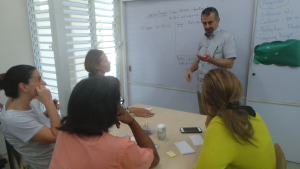 The coordinator, Rachid, handed out role play cards to teachers. One said, “Nod your head every time the teacher asks if you understand or get it.” All the others said, “Look at the teacher and don’t react whenever he asks if you understand or get it.”
The coordinator, Rachid, handed out role play cards to teachers. One said, “Nod your head every time the teacher asks if you understand or get it.” All the others said, “Look at the teacher and don’t react whenever he asks if you understand or get it.”
Rachid gave a difficult math lesson and quickly checked for understanding by asking, “Does everyone understand?” “Do you get it?” “Everyone okay so far?” etc. As soon as he glanced at the student who was nodding his/her head, he would smile broadly and say, “Okay, good. Let’s move on.”
Reflection:
At the end of our workshop, teachers debriefed. We discussed the fact that this is a strategy that many teachers inadvertently use. Most teachers reported feeling that, even though this was simply role play, they felt completely frustrated and even angry with the situation. How often do we look around a classroom, see a few confident students, and move on thinking that everyone understands? What are some better methods we can use to measure understanding?
Center 2: Analysis of Exit Slips
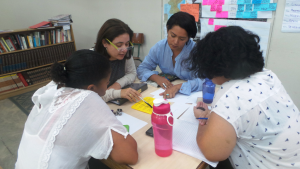 The following instructions were given to the teachers:
The following instructions were given to the teachers:
“The fifth grade teachers are teaching ‘metaphor’ to their students. (A metaphor is a comparison of two unlike things without using “like” or “as.”) At the end of the class, to check for understanding, they asked students to write a metaphor of their own as an exit slip.
“Look at Juan’s class exit slips and analyze them. What does Juan need to do next to make sure his students understand the concept? Next, look at Debbie’s class exit slips and analyze them. What does Debbie’s class need to do nest to make sure her students understand the concept?
“Jot down your ideas on the paper provided.”
Teachers then opened up an envelope containing eight exit slips for Juan’s class, in which two students had written metaphors, two had written similes, and four had written comparisons. The envelope for Debbie’s class contained eight exit slips, in which six students had written metaphors and two had written similes.
Teachers analyzed the class exit slips and came up with lesson plans for the next day’s class for each teacher.
Reflection:
In our debriefing session, teachers reported that they had a stronger understanding of what to do with exit slips following the workshop. Many teachers said that they generally grade the slips as a short quiz, but don’t do an analysis of them to see where students are in their understanding. It became clear that rather than using exit slips to grade students, we should use them to help us improve our own teaching.
Center 3: Thumbs Up, Thumbs Down
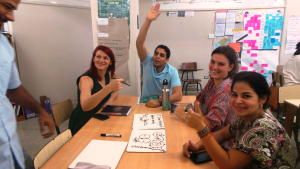 The coordinator, Dennis, explained the thumbs up/thumbs down method of checking for understanding: students put their thumb up if they understand, down if they don’t, and in the middle if they have some understanding.
The coordinator, Dennis, explained the thumbs up/thumbs down method of checking for understanding: students put their thumb up if they understand, down if they don’t, and in the middle if they have some understanding.
Dennis taught a difficult science lesson, pausing to check for understanding and re-teaching as necessary.
Reflection:
When teachers debriefed, they all stated that they felt secure and supported throughout this lesson. They didn’t feel uncomfortable admitting that they were lost and they liked the fact that the teacher immediately retaught the lesson.
Center 4: Invent the Quiz
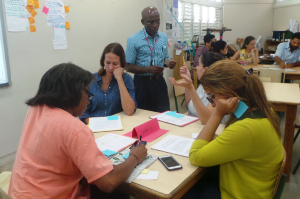 The coordinator, Lincoln, taught a history lesson and asked teachers to show their understanding by coming up with an open-ended question about the lesson that they might find on a quiz. He would analyze these questions later to see how well their ability to ask questions reflected their understanding of the material.
The coordinator, Lincoln, taught a history lesson and asked teachers to show their understanding by coming up with an open-ended question about the lesson that they might find on a quiz. He would analyze these questions later to see how well their ability to ask questions reflected their understanding of the material.
Reflection:
In debriefing, teachers said they felt less supported by this method. Although Lincoln was able to measure their understanding and use it to plan for the next class, several of them felt lost in his lesson and had no way to inform him. Re-teaching wasn’t done on the spot as it was in the “thumbs up, thumbs down” lesson. They felt that this method might help inform the teacher of student understanding, but it didn’t help him make adjustments in the lesson when they didn’t understand.
Professional Development Takeaways
By the end of our debriefing session, we had discussed different reasons why students don’t ask questions when they feel lost and what we could do about it. Teachers shared ideas about different ways they could check for understanding, and most of them had come to the realization that they needed to incorporate more of these techniques in their classroom. Through the use of centers, our workshop moved quickly, everyone was actively engaged, deep discussions took place, and teachers were in charge of their own learning. I think that’s what good PD is all about.

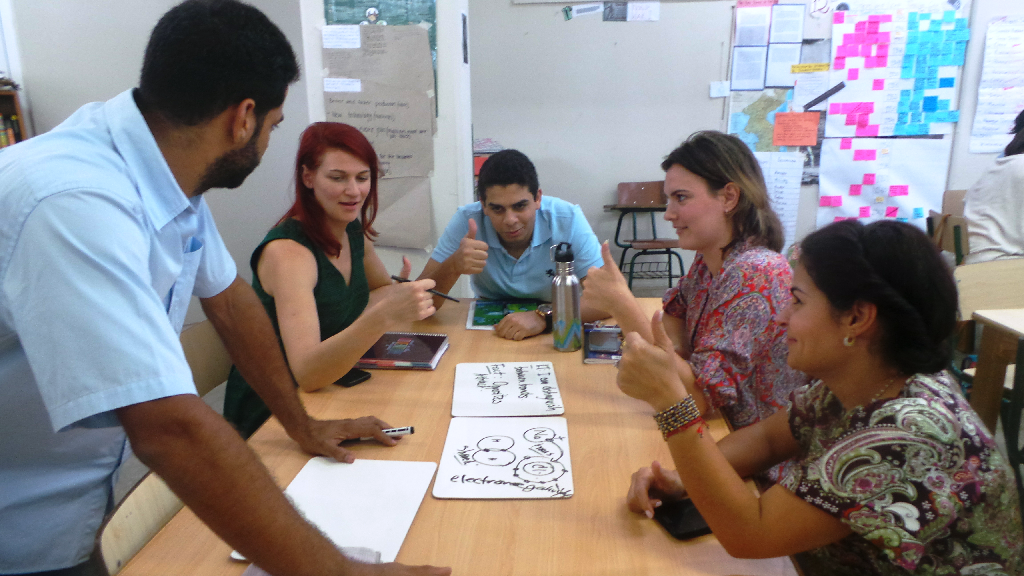
Leave a comment